Abstract
In vitro antifungal susceptibility testing generally remains unstandardized and unreliable for directing therapy. When azoles are tested, this problem is further compounded by the lack of definite reading end points. We determined the in vitro susceptibility of 50 Candida albicans isolates (including 10 reference strains) to fluconazole by using a microbroth dilution method in which microtiter plates were agitated immediately before reading. Six fungal inoculum sizes (ranging from 2 x 10(2) to 4 x 10(5) CFU/ml), three different times of reading (24, 48, and 72 h), and two temperatures (30 and 35 degrees C) were tested. We also compared visual and spectrophotometric determinations of MIC end points. This agitation method resulted in clear-cut visual end points that were reproducible for different observers within the same laboratory, that were independent of inoculum size, temperature of incubation, and time of reading, and that correlated well with the degree of fungal inhibition as determined by spectrophotometry. Median MICs also correlated with usually achievable levels of fluconazole in serum and tissue of humans and experimental animals.
Full text
PDF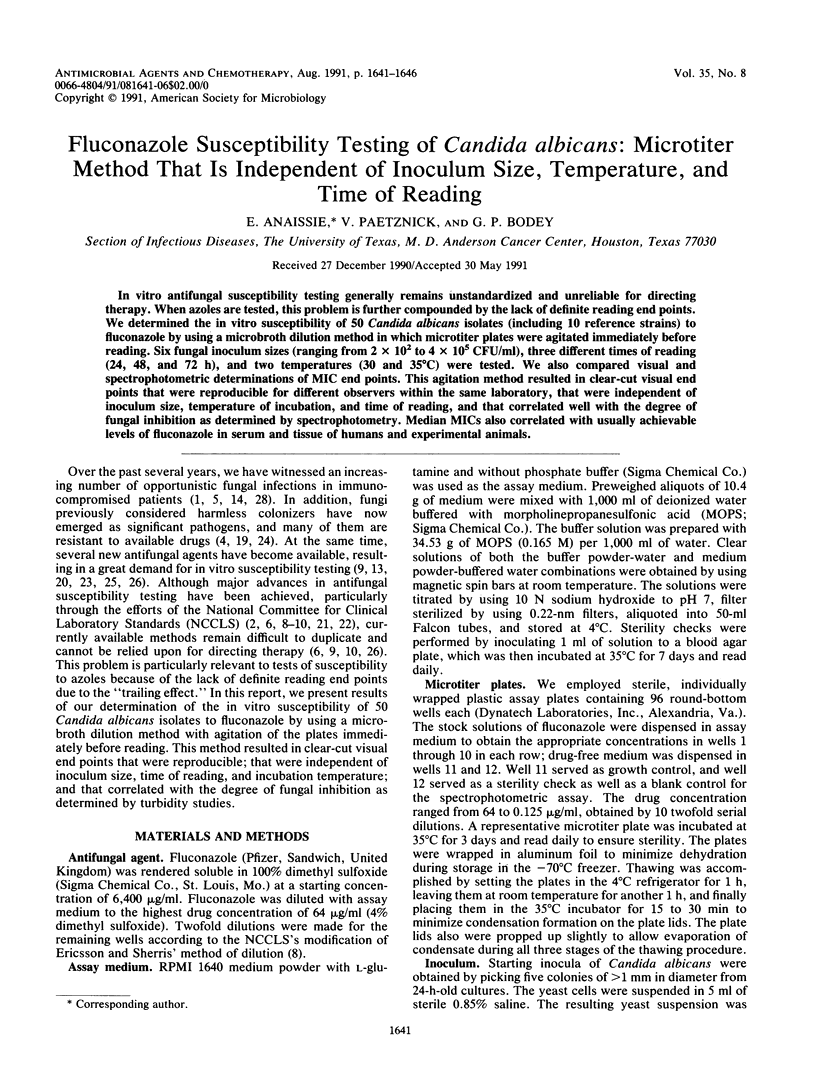
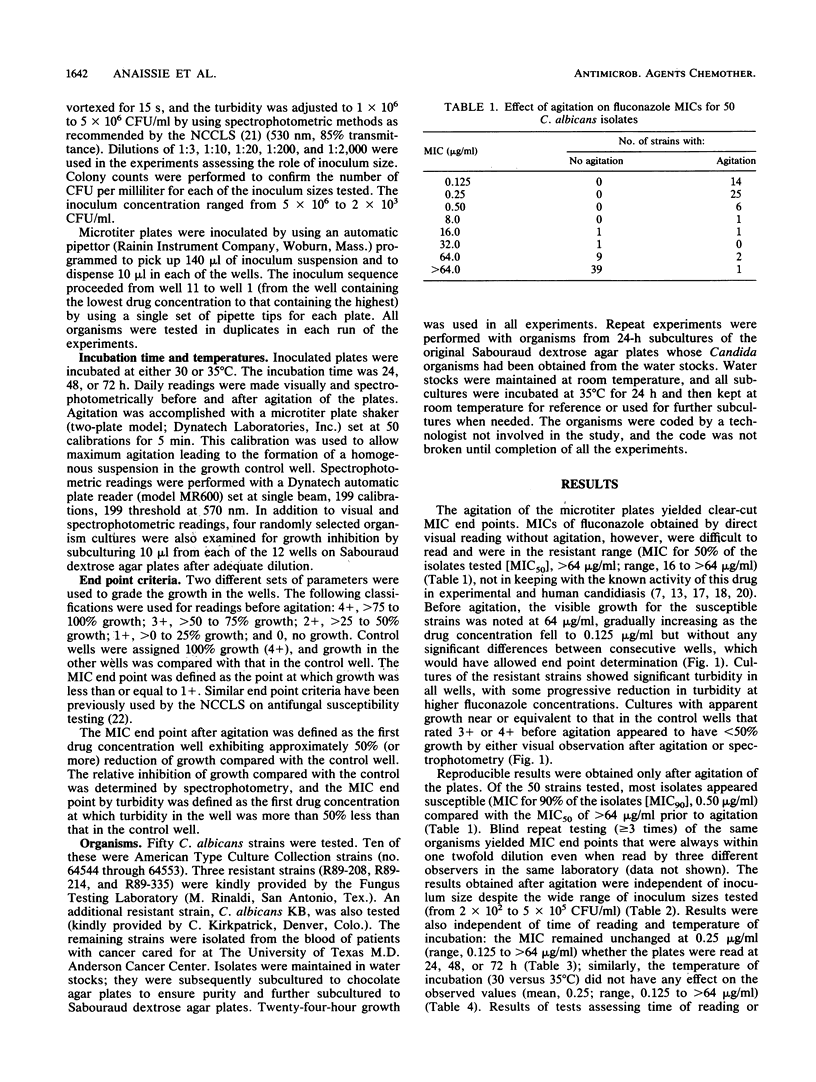
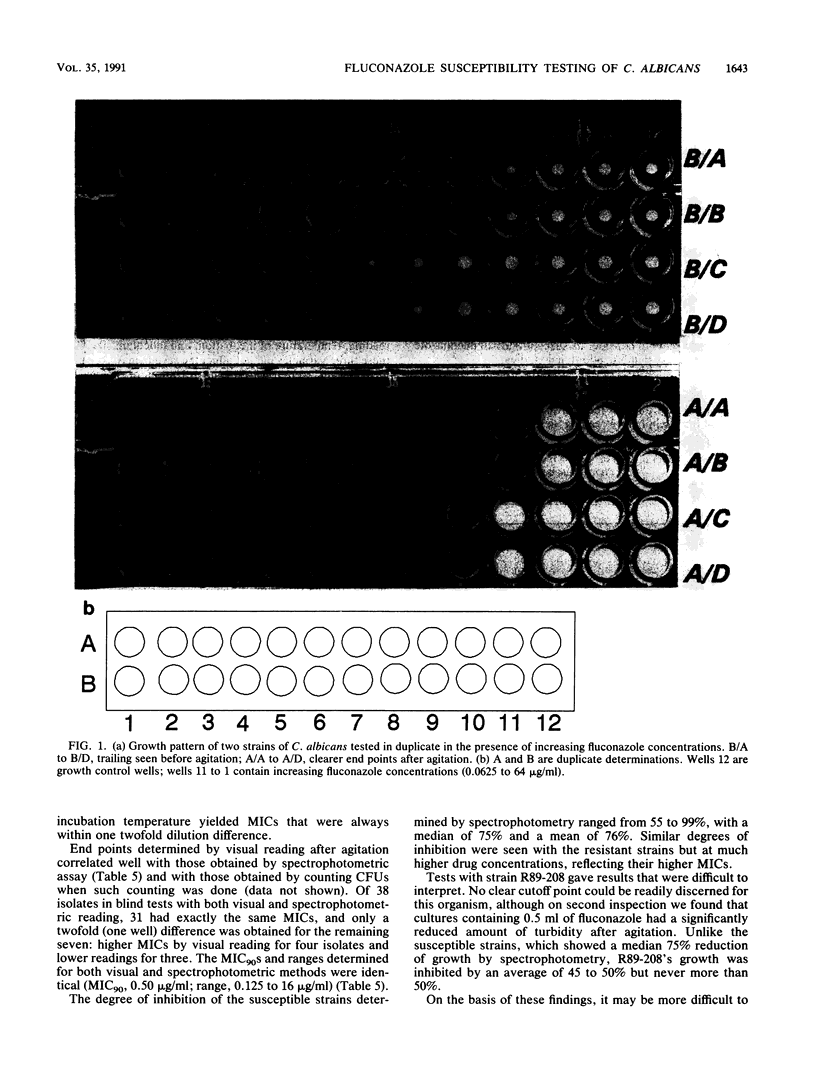
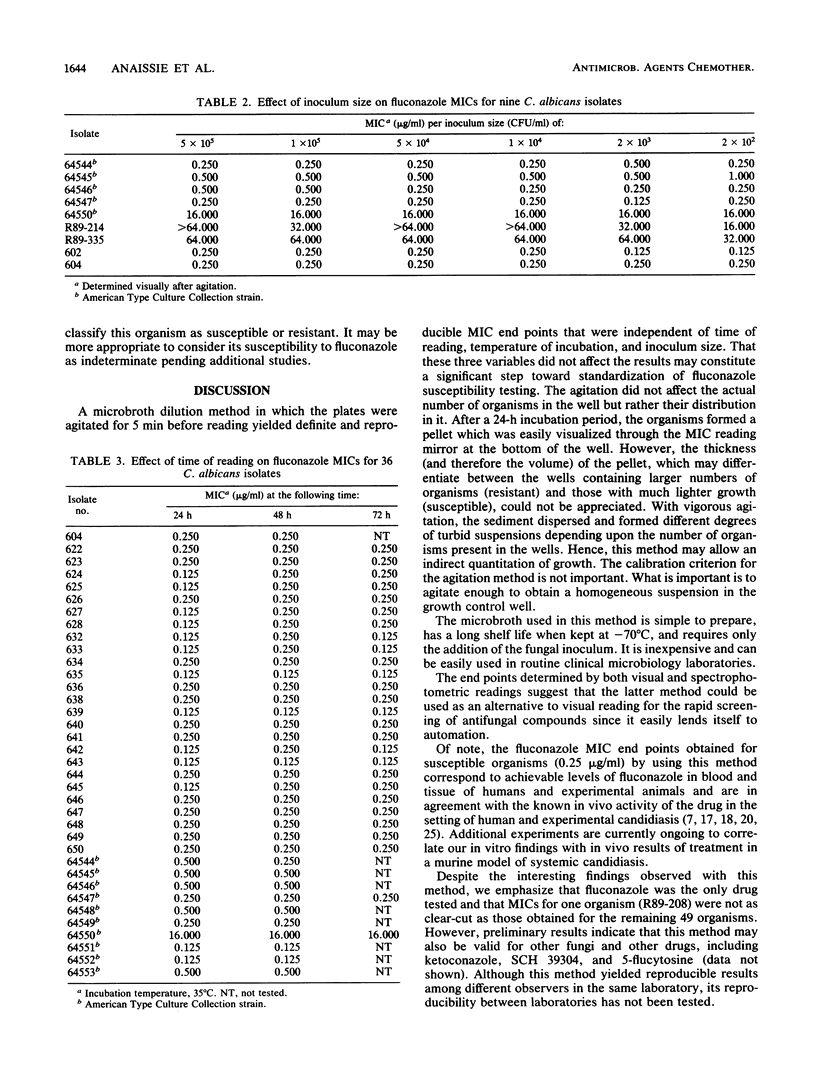
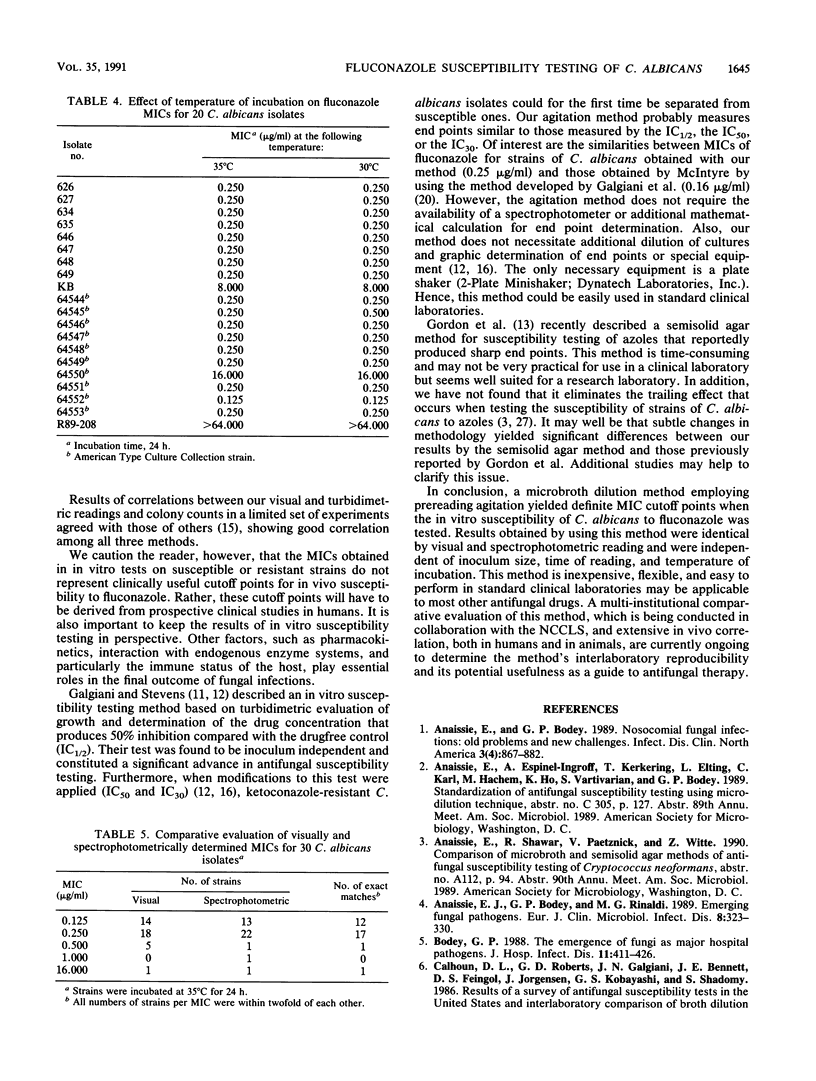
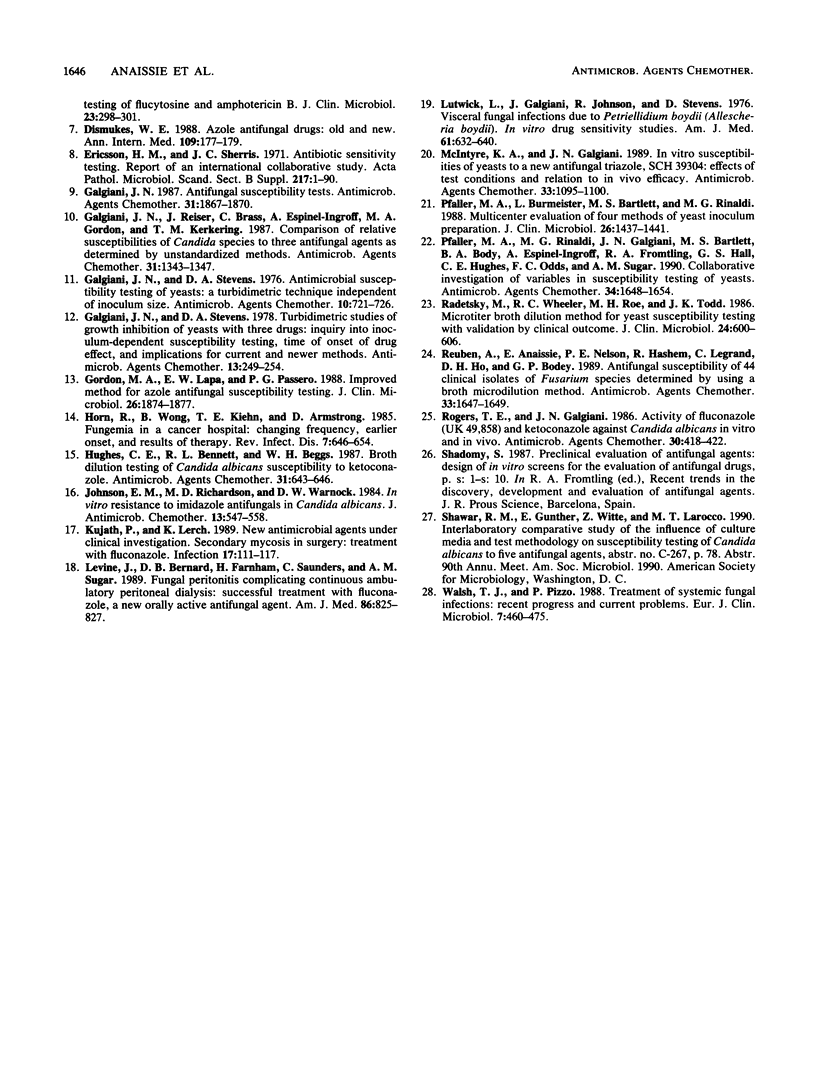
Images in this article
Selected References
These references are in PubMed. This may not be the complete list of references from this article.
- Anaissie E. J., Bodey G. P., Rinaldi M. G. Emerging fungal pathogens. Eur J Clin Microbiol Infect Dis. 1989 Apr;8(4):323–330. doi: 10.1007/BF01963467. [DOI] [PubMed] [Google Scholar]
- Anaissie E., Bodey G. P. Nosocomial fungal infections. Old problems and new challenges. Infect Dis Clin North Am. 1989 Dec;3(4):867–882. [PubMed] [Google Scholar]
- Bodey G. P. The emergence of fungi as major hospital pathogens. J Hosp Infect. 1988 Feb;11 (Suppl A):411–426. doi: 10.1016/0195-6701(88)90220-4. [DOI] [PubMed] [Google Scholar]
- Dismukes W. E. Azole antifungal drugs: old and new. Ann Intern Med. 1988 Aug 1;109(3):177–179. doi: 10.7326/0003-4819-109-3-177. [DOI] [PubMed] [Google Scholar]
- Galgiani J. N. Antifungal susceptibility tests. Antimicrob Agents Chemother. 1987 Dec;31(12):1867–1870. doi: 10.1128/aac.31.12.1867. [DOI] [PMC free article] [PubMed] [Google Scholar]
- Galgiani J. N., Reiser J., Brass C., Espinel-Ingroff A., Gordon M. A., Kerkering T. M. Comparison of relative susceptibilities of Candida species to three antifungal agents as determined by unstandardized methods. Antimicrob Agents Chemother. 1987 Sep;31(9):1343–1347. doi: 10.1128/aac.31.9.1343. [DOI] [PMC free article] [PubMed] [Google Scholar]
- Galgiani J. N., Stevens D. A. Antimicrobial susceptibility testing of yeasts: a turbidimetric technique independent of inoculum size. Antimicrob Agents Chemother. 1976 Oct;10(4):721–728. doi: 10.1128/aac.10.4.721. [DOI] [PMC free article] [PubMed] [Google Scholar]
- Galgiant J. N., Stevens D. A. Turbidimetric studies of growth inhibition of yeasts with three drugs: inquiry into inoculum-dependent susceptibility testing, time of onset of drug effect, and implications for current and newer methods. Antimicrob Agents Chemother. 1978 Feb;13(2):249–254. doi: 10.1128/aac.13.2.249. [DOI] [PMC free article] [PubMed] [Google Scholar]
- Gordon M. A., Lapa E. W., Passero P. G. Improved method for azole antifungal susceptibility testing. J Clin Microbiol. 1988 Sep;26(9):1874–1877. doi: 10.1128/jcm.26.9.1874-1877.1988. [DOI] [PMC free article] [PubMed] [Google Scholar]
- Horn R., Wong B., Kiehn T. E., Armstrong D. Fungemia in a cancer hospital: changing frequency, earlier onset, and results of therapy. Rev Infect Dis. 1985 Sep-Oct;7(5):646–655. doi: 10.1093/clinids/7.5.646. [DOI] [PubMed] [Google Scholar]
- Hughes C. E., Bennett R. L., Beggs W. H. Broth dilution testing of Candida albicans susceptibility to ketoconazole. Antimicrob Agents Chemother. 1987 Apr;31(4):643–646. doi: 10.1128/aac.31.4.643. [DOI] [PMC free article] [PubMed] [Google Scholar]
- Johnson E. M., Richardson M. D., Warnock D. W. In-vitro resistance to imidazole antifungals in Candida albicans. J Antimicrob Chemother. 1984 Jun;13(6):547–558. doi: 10.1093/jac/13.6.547. [DOI] [PubMed] [Google Scholar]
- Kujath P., Lerch K. Secondary mycosis in surgery: treatment with fluconazole. Infection. 1989 Mar-Apr;17(2):111–117. doi: 10.1007/BF01646895. [DOI] [PubMed] [Google Scholar]
- Levine J., Bernard D. B., Idelson B. A., Farnham H., Saunders C., Sugar A. M. Fungal peritonitis complicating continuous ambulatory peritoneal dialysis: successful treatment with fluconazole, a new orally active antifungal agent. Am J Med. 1989 Jun;86(6 Pt 2):825–827. doi: 10.1016/0002-9343(89)90481-6. [DOI] [PubMed] [Google Scholar]
- Lutwick L. I., Galgiani J. N., Johnson R. H., Stevens D. A. Visceral fungal infections due to Petriellidium boydii (allescheria boydii). In vitro drug sensitivity studies. Am J Med. 1976 Nov;61(5):632–640. doi: 10.1016/0002-9343(76)90141-8. [DOI] [PubMed] [Google Scholar]
- McIntyre K. A., Galgiani J. N. In vitro susceptibilities of yeasts to a new antifungal triazole, SCH 39304: effects of test conditions and relation to in vivo efficacy. Antimicrob Agents Chemother. 1989 Jul;33(7):1095–1100. doi: 10.1128/aac.33.7.1095. [DOI] [PMC free article] [PubMed] [Google Scholar]
- Pfaller M. A., Burmeister L., Bartlett M. S., Rinaldi M. G. Multicenter evaluation of four methods of yeast inoculum preparation. J Clin Microbiol. 1988 Aug;26(8):1437–1441. doi: 10.1128/jcm.26.8.1437-1441.1988. [DOI] [PMC free article] [PubMed] [Google Scholar]
- Pfaller M. A., Rinaldi M. G., Galgiani J. N., Bartlett M. S., Body B. A., Espinel-Ingroff A., Fromtling R. A., Hall G. S., Hughes C. E., Odds F. C. Collaborative investigation of variables in susceptibility testing of yeasts. Antimicrob Agents Chemother. 1990 Sep;34(9):1648–1654. doi: 10.1128/aac.34.9.1648. [DOI] [PMC free article] [PubMed] [Google Scholar]
- Radetsky M., Wheeler R. C., Roe M. H., Todd J. K. Microtiter broth dilution method for yeast susceptibility testing with validation by clinical outcome. J Clin Microbiol. 1986 Oct;24(4):600–606. doi: 10.1128/jcm.24.4.600-606.1986. [DOI] [PMC free article] [PubMed] [Google Scholar]
- Reuben A., Anaissie E., Nelson P. E., Hashem R., Legrand C., Ho D. H., Bodey G. P. Antifungal susceptibility of 44 clinical isolates of Fusarium species determined by using a broth microdilution method. Antimicrob Agents Chemother. 1989 Sep;33(9):1647–1649. doi: 10.1128/aac.33.9.1647. [DOI] [PMC free article] [PubMed] [Google Scholar]
- Rogers T. E., Galgiani J. N. Activity of fluconazole (UK 49,858) and ketoconazole against Candida albicans in vitro and in vivo. Antimicrob Agents Chemother. 1986 Sep;30(3):418–422. doi: 10.1128/aac.30.3.418. [DOI] [PMC free article] [PubMed] [Google Scholar]
- Walsh T. J., Pizzo A. Treatment of systemic fungal infections: recent progress and current problems. Eur J Clin Microbiol Infect Dis. 1988 Aug;7(4):460–475. doi: 10.1007/BF01962595. [DOI] [PubMed] [Google Scholar]



